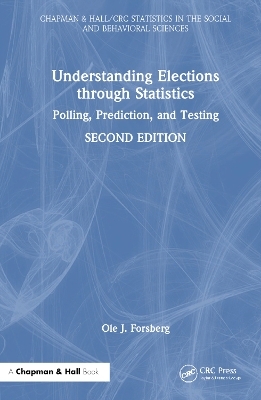
Understanding Elections through Statistics
Chapman & Hall/CRC (Verlag)
978-1-032-68453-6 (ISBN)
Elections are random events.
From individuals deciding whether to vote, to individuals deciding who to vote for, to election authorities deciding what to count, the outcomes of competitive democratic elections are rarely known until election day… or beyond. Understanding Elections through Statistics explores this random phenomenon from three primary points of view: predicting the election outcome using opinion polls, testing the election outcome using government-reported data, and exploring election data to better understand the people.
Written for those with only a brief introduction to statistics, this book takes you on a statistical journey from how polls are taken to how they can—and should—be used to estimate current popular opinion. Once an understanding of the election process is built, we turn toward testing elections for evidence of unfairness. While holding elections has become the de facto proof of government legitimacy, those electoral processes may hide the dirty little secret of the government, illicitly ensuring a favorable election outcome.
This book includes these features designed to make your statistical journey more enjoyable:
Vignettes of elections, including maps, starting each chapter to motivate the material
In-chapter cues to help one avoid the heavy math—or to focus on it
End-of-chapter problems designed to review and extend what was covered in the chapter
Many opportunities to turn the power of the R Statistical Environment to the enclosed election data files, as well as to those you find interesting
The second edition improves upon this and includes:
A rewrite of several chapters to make the underlying concepts more clear
A chapter dedicated to confidence intervals, what they mean, and what they do not
Additional experiments to help you better understand the statistics of elections
A new introduction to polling, its terms, its processes, and its ethics
From these features, it is clear that the audience for this book is quite diverse. It provides the statistics and mathematics for those interested in statistics and mathematics, but it also provides detours for those who just want a good read and a deeper understanding of elections.
Ole J. Forsberg, PhD, is an Associate Professor of Mathematics-Statistics and the Associate Dean of Faculty Affairs at Knox College in Galesburg, IL. He received a PhD in Political Science from the University of Tennessee-Knoxville in 2006, concentrating in International Relations, War, and Terrorism. After finishing his dissertation, Forsberg began a deeper investigation of the statistical techniques he used there. As a result of the ensuing embarrassment, he began formal graduate statistical studies at the Johns Hopkins University (MSE, 2010) and concluded them with a PhD in Statistics from Oklahoma State University in 2014 (Go Pokes!). His statistics dissertation explored and applied statistical techniques to testing elections for violations of the “free and fair” democratic claim. His research agenda lies in extending and applying statistical methods to elections with the goal of drawing as much out of the available information as possible. . . whether this is in terms of understanding political polls, predicting election outcomes, or testing elections for unfairness.
1. Introduction to Polling. 2. Simple Random Sampling. 3. Interval Estimation. 4. Stratified Sampling. 5. The Bayesian Solution. 6. Aggregating Polls. 7. Going Beyond the Two-Race. 8. Testing Elections: Digit Tests. 9. Testing Elections: Regression Tests. 10. Election Polling Analysis: Brexit Vote, 2016. 11. Election Analysis: Collier County. 12. System Analysis: Sri Lanka since 1994. 13. An Afterword: Biases in Polling.
| Erscheinungsdatum | 18.10.2024 |
|---|---|
| Reihe/Serie | Chapman & Hall/CRC Statistics in the Social and Behavioral Sciences |
| Zusatzinfo | 11 Tables, black and white; 128 Line drawings, black and white; 128 Illustrations, black and white |
| Sprache | englisch |
| Maße | 156 x 234 mm |
| Gewicht | 657 g |
| Themenwelt | Geisteswissenschaften ► Psychologie ► Allgemeine Psychologie |
| Mathematik / Informatik ► Mathematik ► Statistik | |
| Sozialwissenschaften ► Politik / Verwaltung ► Staat / Verwaltung | |
| ISBN-10 | 1-032-68453-4 / 1032684534 |
| ISBN-13 | 978-1-032-68453-6 / 9781032684536 |
| Zustand | Neuware |
| Haben Sie eine Frage zum Produkt? |
aus dem Bereich


